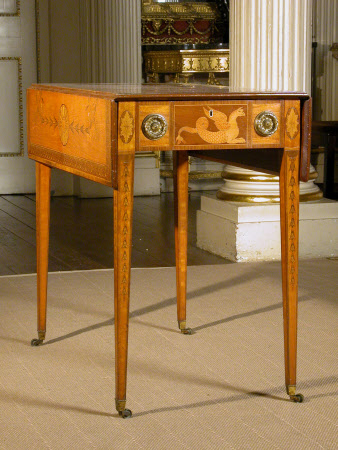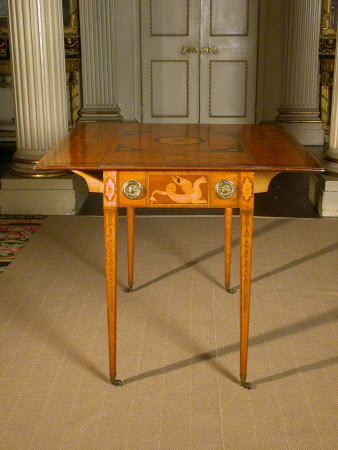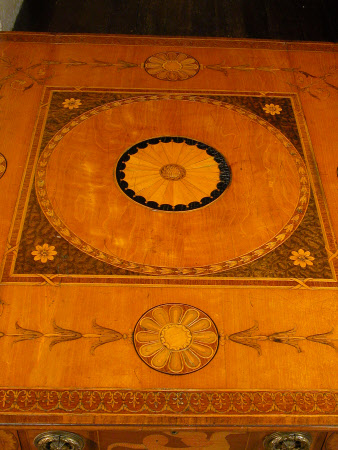Pembroke table
William Ince & John Mayhew (fl. 1759-1803)
Category
Furniture
Date
circa 1775
Materials
Oak, tulipwood, purpleheart, mahogany, satinwood and a variety of tropical hardwoods, gilt brass
Measurements
71 x 81 x 81 cm
Place of origin
London
Order this imageCollection
Saltram, Devon
NT 871333
Summary
An inlaid satinwood Pembroke table, English, circa 1775, by Ince & Mayhew, London (fl. 1758/9-1804). Inlaid to the top with a patera against a black ground, within a satinwood circle and a variety of inlaid motives and reserves. The top's edge inlaid with a delicate run of anthemion-type flowers. One frieze fitted with a drawer inlaid with a distinctive scaly wyvern with curly tail set against a darker rectangular reserve. The legs square-section and tapering and banded, and with brass caps and castors.
Full description
The two surviving cash books relating to expenditure at Saltram between 1770-8 and 1778-88 do not refer to Ince & Mayhew (fl. 1758/9-1804) but the firm is referred to in a letter from Frederick Robinson to his sister Theresa (1745-75) the wife of John Parker II, 1st Lord Boringdon (1734/5-88) written in 1773. Writing from Madrid, Frederick commenting on the French furniture of the Duke of Villa Hermosa said: 'I hope Ince and Mayhew keep to the old style instead of attempting landscapes on woodwork' thus raising the suggestion of a relationship with the firm of cabinet-makers, if not a commission. This Pembroke table - recently described as 'exceptionally refined' - is the only surviving piece of furniture at Saltram which can be firmly attributed to the firm. Its marquetry incorporates a wyvern, an unusual mythical reference which is nonetheless found on pieces of documented Ince & Mayhew furniture (such as a commode in the Lady Lever Art Gallery and a writing table formerly at The Durdans, Epsom), as well as a number of other features (including the materials used and the handles) which are considered typical of the firm.
Provenance
Date of introduction to Saltram not recorded but at Saltram by 1951 and accepted by HM Treasury in lieu of full payment of Death Duty from the Executors of Edmund Robert Parker (1877 - 1951), 4th Earl of Morley and transferred to the National Trust in 1957.
Makers and roles
William Ince & John Mayhew (fl. 1759-1803), cabinetmaker
References
Wood, 1994: Lucy Wood, The Lady Lever Art Gallery, Catalogue of Commodes, London, 1994, pp. 226 - 235 and Colour Plate 29 H. Roberts and C. Cator, Industry and Ingenuity: The Partnership of William Ince and John Mayhew (Philip Wilson: London, 2022),, pp. 254-5 and figs 431 and 432.


